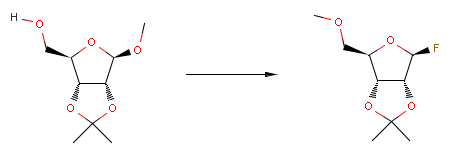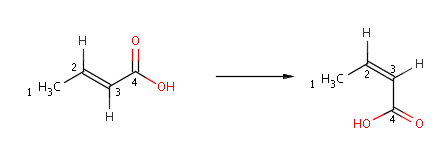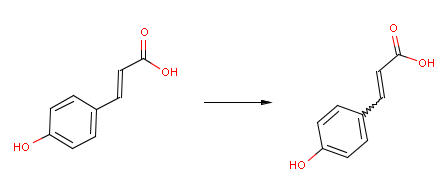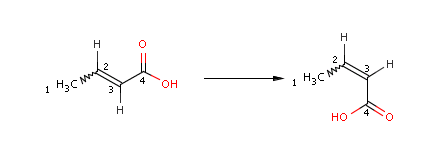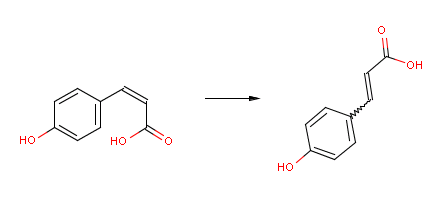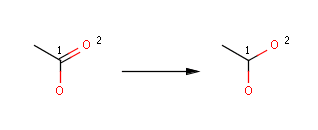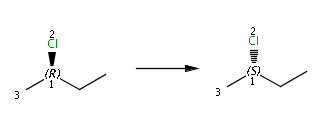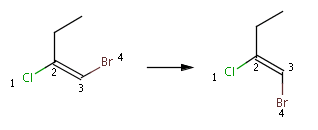Reaction stereo
Chirality REVIEW
Reaction stereo centers can be defined in two ways:
-
as an INVRET (inversion/retention) atom property in the MOL (or RXN, RDF) form
-
by setting atom parity using up/down-wedge bonds
In both cases the stereo center should be mapped with the same atom map on the reactant and the product sides.
The difference is that while reactions defined by the INVRET atom property match both stereo configurations as well as the non-stereo form, the up/down wedge stereo definition will only match the stereo configuration specified in the reactant side of the reaction.
While the first possibility is more effective, it is not available in SMILES.
If reaction stereo information is given by the second option and there are at least two unmapped non-hydrogen ligands connected to the stereo center, then the INVRET (inversion/retention) atom property is first determined by preprocessing the reaction and then the reaction processing is done as in the first case. If the ligands of the stereo center are sufficiently mapped (that is, there is at most one unmapped non-hydrogen ligands) then there is no need of this preprocession and the reaction handling is more effective.
The advantage of the second option is that it is also available in SMILES.
If the RETENTION atom property is specified then the stereo configuration in the reactants is kept in the products, while in case of INVERSION the stereo configuration is inverted.
Limitations:
-
by setting atom parity using up/down-wedge bonds (second option) with at least two unmapped non-hydrogen ligands only one stereo center can be specified per reaction
-
the stereo configuration can be processed only if at most one atom changes around the stereo center
Examples:
The following reaction defines a stereoselective reaction:
|
|
Reactor reacts the first compound according to the above equation, but not the second one, since the reactant is not matching:
|
|
|
|
The inversion/retention flag can be used to define stereoselective reactions producing the appropriate chiral compounds from both enantiomers. The definition:
|
|
and the actual stereo reactions inverting the reaction center (please note, that the third reactant is racemic, thus the product is racemic as well; toluene-p-sulphonic acid is not shown in the example):
|
|
|
|
|
|
Double bond stereo
To propagate the cis/trans stereo configuration in the reaction definition to the reaction product, the corresponding four atoms should be mapped. For example, the following reaction changes the double bond configuration from cis to trans. Reactor can process double bond isomerisation reactions when the corresponding double bond ligands (at least four atoms) are mapped (the small square on the double bond marks stereo specific matching):
|
|
The actual reaction equations. The trans-coumarin is transformed while the cis isomer is not:
|
|
|
|
Instead of CIS or TRANS configuration on the product side, you can also specify an undetermined double bond stereo configuration, denoted by a wiggly bond:
|
|
In this case you will get the same cis-or-trans configuration in the actual product, denoted by a wiggly bond in the same way as in the reaction equation:
|
|
If you also set unspecified double bond stereo on the reactant side of the reaction equation:
|
|
then the cis-coumarin will also be transformed:
|
|
Double bond stereo configuration on atoms not taking part in the reaction is left unchanged; however, there may be cases when the double bond stereo type cannot be determined: if the double bond has stereo configuration (that is, different ligands attached to at least one of the end-atoms) but there is neither an unmapped, nor a fully mapped A1-A2=A3-A4 configuration along which the configuration could be determined. In such cases an error is reported in command-line interface if the --check parameter is specified, otherwise the double bond stereo type is unpredictable. To prevent this, map a full A1-A2=A3-A4 atom configuration for each double bond on the product side of the reaction that has at least one mapped ligand.
Examples:
|
changing bond type |
|
|
orphan atoms |
|
|
chirality |
|
|
double bond stereo |
|

